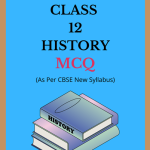NCERT Class 12 History MCQ Chapter 13 Mahatma Gandhi and The Nationalist Movement Solutions to each chapter is provided in the list so that you can easily browse through different chapters NCERT Class 12 History MCQ Chapter 13 Mahatma Gandhi and The Nationalist Movement and select need one. NCERT Class 12 History MCQ Chapter 13 Mahatma Gandhi and The Nationalist Movement Question Answers Download PDF. NCERT History MCQ Class 12 Solutions.
NCERT Class 12 History MCQ Chapter 13 Mahatma Gandhi and The Nationalist Movement
Also, you can read the NCERT book online in these sections Solutions by Expert Teachers as per Central Board of Secondary Education (CBSE) Book guidelines. CBSE Class 12 History MCQ Solutions are part of All Subject Solutions. Here we have given NCERT Class 12 History MCQ Part – I: Themes in Indian History, History MCQ Part – II: Themes in Indian History, History MCQ Part – III: Themes in Indian History. NCERT Class 12 History MCQ Chapter 13 Mahatma Gandhi and The Nationalist Movement Notes, NCERT Class 12 History MCQ Notes for All Chapters, You can practice these here.
Mahatma Gandhi and The Nationalist Movement
Chapter: 13
| THEMES IN INDIAN HISTORY (PART – III) |
| MCQ |
1. Gandhiji’s political mentor was:
(a) Lala Lajpat Roy.
(b) Bipin Chandra Pal.
(c) Gopal Krishna Gokhale.
(d) Bal Gangadhar Tilak.
Ans: (c) Gopal Krishna Gokhale.
2. Lal, Bal and Pal were associated with the:
(a) Moderate group of leaders of congress.
(b) Radical nationalists.
(c) Terrorists.
(d) Revolutionaries.
Ans: (b) Radical nationalists.
3. Mahatma Gandhi returns from South Africa in:
(a) 1912.
(b) 1913.
(c) 1914.
(d) 1915.
Ans: (d) 1915.
4. Champaran movement was launched in:
(a) 1917.
(b) 1918.
(c) 1919.
(d) 1916 5.
Ans: (a) 1917.
5. Jallianwala Bagh massacre took place on:
(a) 13th April, 1919.
(b) 13th April, 1918.
(c) 13th April, 1920.
(d) 13th April, 1917.
Ans: (a) 13th April, 1919.
6. Purna Swaraj was accepted by Congress under the Chairmanship of:
(a) Jawaharlal Nehru.
(b) Mahatma Gandhi.
(c) Motilal Nehru.
(d) None of the above.
Ans: (a) Jawaharlal Nehru.
7. When and where Purna Swaraj was accepted as Congress goal?
(a) 1929, Lahore.
(b) 1928, Karachi.
(c) 1930, Peshawar.
(d) 1931, Surat.
Ans: (a) 1929, Lahore.
8. Dandi March of March-April 1930 is related initially with:
(a) Salt Satyagraha and breaking of salt law of the British Government.
(b) Peaceful march and supporting the cause of Khilafat.
(c) Non-violent demonstration for the Indian women empowerment.
(d) For preparing ground for Round Table Conferences.
Ans: (a) Salt Satyagraha and breaking of salt law of the British Government.
9. Congress did not participate at all in:
(a) First Round Table Conference.
(b) Second Round Table Conference.
(c) Gandhi-Irwin Pact related Conference.
(d) None of the above mentioned.
Ans: (a) First Round Table Conference.
10. Who persuaded Gandhiji not to restrict the protests to men alone?
(a) Kamaladevi Chattopadhyay.
(b) Sarojini Naidu.
(c) Annie Basant.
(d) Mira Ben.
Ans: (a) Kamaladevi Chattopadhyay.
11. Jinnah called for a “Direct Action Day to press the League’s demand for Pakistan. On the designated day, 16 August 1946, bloody riots broke out in Calcutta:
(a) 16 August 1946.
(b) 16 September 1946.
(c) 15 August 1946.
(d) 16 August 1945.
Ans: (a) 16 August 1946.
12. Mahatma Gandhi was not present at the festivities in the capital on 15 August 1947. He was in:
(a) Lucknow.
(b) Calcutta.
(c) Amritsar.
(d) Bombay.
Ans: (b) Calcutta.
13. Which one of the following began with the Dandi March?
(a) Home Rule Movement.
(b) Non-Cooperation Movement.
(c) Civil Disobedience Movement.
(d) Quit India Movement.
Ans: (c) Civil Disobedience Movement.
14. A novel and remarkable feature of the Civil Disobedience Movement was the widespread participation of:
(a) peasants.
(b) students.
(c) women.
(d) industrialists and merchants.
Ans: (c) women.
15. Quit India Movement began in:
(a) August, 1942.
(b) February, 1942.
(c) March, 1942.
(d) April, 1942.
Ans: (a) August, 1942.

Hi! my Name is Parimal Roy. I have completed my Bachelor’s degree in Philosophy (B.A.) from Silapathar General College. Currently, I am working as an HR Manager at Dev Library. It is a website that provides study materials for students from Class 3 to 12, including SCERT and NCERT notes. It also offers resources for BA, B.Com, B.Sc, and Computer Science, along with postgraduate notes. Besides study materials, the website has novels, eBooks, health and finance articles, biographies, quotes, and more.




